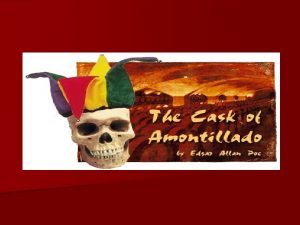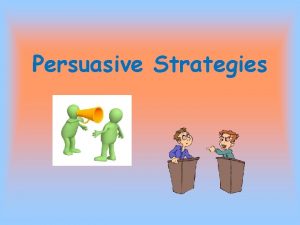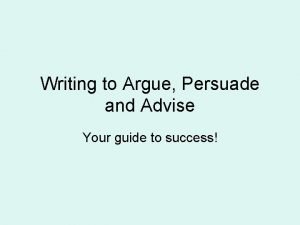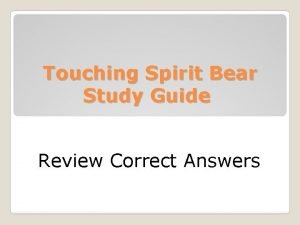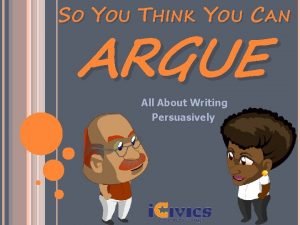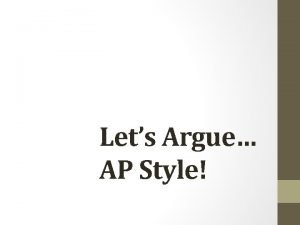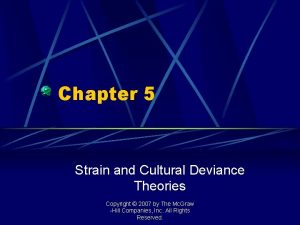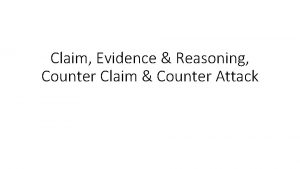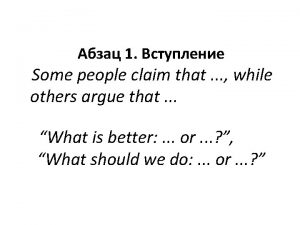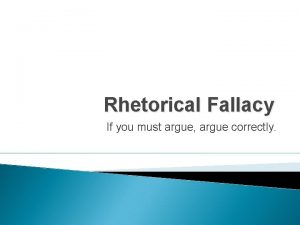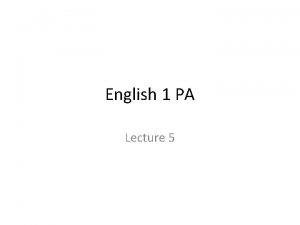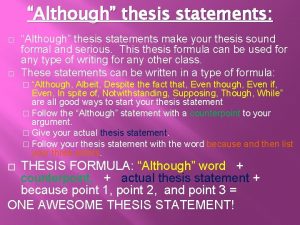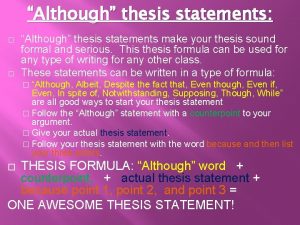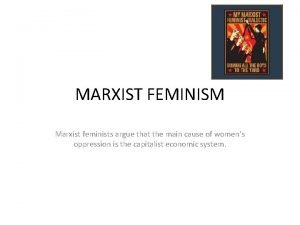MAIN CLAIM Although some may argue that art























- Slides: 23

MAIN CLAIM: Although some may argue that art education should not be valued, academic research and studies prove that art in schools is incredibly beneficial. Strong art programs can improve the school environment and community relations, as well as the individual student. Madeline Denton

YES SOURCES

Should a visual arts education Be in schools?

1 YES Community and Art: creative education fostering resilience through art Hyungsook Kim • The author, Hyungsook Kimof the source, “Community and Art: creative education fostering resilience through art” is a professor at the College of Fine Arts Seoul National University in Seoul, South Korea. She has been published in many other scholarly journals on the topics of art, education, and culture. This article can be found in the Asia Pacific Education Review, which is a credible academic journal. Kim’s writing is definitely the most credible because of her education, the journal’s reputation, and the use of strong research. “Community and Art” is an organized source with good supporting details. Although the study is a bit bias- due to the fact that Kim is an arts educator trying to promote the arts- she tries to stay as objective as possible through solid research. I plan to keep this source in my final paper because of its positive research with solid evidence. It brings new information to my topic, which is important to strengthen my argument and to avoid stereotypical evidence. - Art and creativity are beneficial to students - Describes how teaching creativity in schools can lessen violence and develop good character. - I learned a lot from the study on violence prevalence verses art programs in Kim’s study. It was proven that art does in fact lessen acts of violence in a school setting, which is a powerful statistic. - SUBCLAIM: THIS SOURCE ALLOWS ME TO ARGUE that art education benefits the community and school by lessening violence and promoting good character.

3 YES Art, Creativity, and the Quality of Education by Jon Murray • The next source is “Art, Creativity, and the Quality of Education” by Jon Murray was published in Daedalus, which is a Journal of the American Academy of Arts and Sciences. The source claims to bring in “the nation’s most prominent thinkers” which authoritative essays. Although this source is peer reviewed, it does not strike me to be as credible as it could be. Jon Murray is a high school art teacher, and his information does not show up in a Google search. The article was written in the 1980’s, so although the information is a true account, it may be outdated in this day and time. Murray’s education is not made clear; the only piece of credibility is that he has worked as a high school art teacher and has been published by a known journal. He is biased because of his personal experiences- an art teacher who advocates for creativity. Although, his experiences make his information a primary source- based on his own observations through his career. I am planning to keep this source because of its fundamental reasons towards the benefits of art education, although it does not bring up especially complex research for the topic. - Art class can benefit students by teaching them to be motivated, caring, dedicated to learning and working, as well as developing better analysis and critical thinking skills. - “Good high-school art instruction teaches students to work independently, to assume increasingly greater responsibility for the direction of their own learning, and to develop the skill of critical self-evaluation” which is describes the benefits he has personally seen in the art classroom that can be translated to other aspects of life. - SUB CLAIM: THIS SOURCE ALLOWS ME TO ARGUE that art education benefits the individual by teaching them better learning skills that they can apply to other aspects of their lives.

4 YES A Journey from STEM to STEAM: A Middle School Case Study by Tracey Hunter-Doniger and Lindsey Sydow 1. Hunter-Doniger: Department of Teacher Education, College of Charleston, South Carolina, USA Sydow: School of Education, Health, and Human Performance, College of Charleston, South Carolina, USA 2. This text is fairly unbiased. The authors are educators, so they are searching to find the most effective way to teach students. The writing is based off of a study compared STEM and STEAM education, so it has data results that are unbiased. • -Increased faculty satisfaction- 93% agreed with STEAM. • CONTENT: • -This article says yes, the arts incorporated in schools is beneficial to learning. • -There are obstacles to including arts- lack of time mainly, lack of funding, less research, informal standards and objectives. • -The study shows effectiveness of STEAM- an 8% improvement of test scores over one year. • SUBCLAIM: THIS SOURCE WILL ALLOW ME TO ARGUE: that incorporating the arts in school is beneficial because it teaches the students new skills increases test scores and faculty satisfaction. • -Teachers who once did not support STEAM changed to like the idea after the study. • -“Encourages students to learn from experiences, make mistakes, explore multiple iterations of a problem, and realize the practical rationale behind the process. “… same with faculty.

6 YES Strong Arts, Strong Schools By CHARLES FOWLER 1. Charles Fowler has a doctor of Musical Arts, but an article about him states, “As a practitioner of several arts with a background of teaching on every level, Dr. Fowler, who is now deceased, was an eloquent spokesman on behalf of the arts in education. ” 2. This source is meant to be informative, but it does include a slight bias because the author is an arts advocate. there ARE NO NEGATIVE ASPECTS TO ART EDUCATION SHARED. • -”The Grand Canyon is over a mile deep, 4 -18 miles wide, more than 200 miles long”. Each of these symbolic systems- words and numbers- permits us to reveal important aspects, but a picture or painting can be equally telling. ” (Page 5) • -”The arts teach divergent rather than convergent thinking” • Arts promote cultural understanding. • Explore emotions • Not just for the gifted and talented, but like math and science they can benefit all. • SUB CLAIM: THIS SOURCE ALLOWS ME TO ARGUE: The benefits of art education in a cultural context. Also specific examples of how art benefits the individual. Fowler, C. (1994). Strong arts, strong schools. Educational Leadership, 52(3), 4. Retrieved 12

5 The Benefits of Art Education By Catherine YES Grytting 1. Grytting is an arts educator, and has a PHD in Educational Leadership and a master of arts degree. 2. Biased because the author is an arts advocate, and shares only the benefits of an arts education. Yet, it is her personal experiences and observations and she is an educated person. • CONTENT: • -Fostering a joy of learning- flow loss of sense of time while being creative. • -Art classes support the development of special, kinesthetic, interpersonal and intrapersonal intelligences. • -Shares a study where academic performance improved with visual arts. • -Emotional growth, social growth. • Creativity helps people become leaders and to identify problems and create new ideas. • -Art is inspiring, • SUB CLAIM: THIS SOURCE WILL ALLOW ME TO ARGUE: the many different ways art benefits students. Listing off different benefits.

Art Education for a Change: Contemporary Issues YES and the Visual Arts By: David Darts 1. 7 David Darts is Director of Global Studies and Chair Emeritus of Steinhardt's Art Department. His research focuses on the convergences between contemporary art and media, technology, education, and democracy. Darts' research and writings about contemporary art, education, emerging technologies and creative citizenship have been published in a number of top scholarly journals and books. (ACCORDING TO NYU) he IS A PROFESSOR AT nyu IN ART EDUCATION. 2. This article does not have a obvious bias like my other sources. • -Socially engaged art education : “Curriculum developed around the belief that the arts can facilitate the development of an ethic of care, thereby enabling participants to positively transform themselves, their communities, and the world in which they live. • -Sense of unity between students. • -Assessment is a collaborative thing between teachers and students- unique to art. • SUB CLAIM: THIS WILL ALOW ME TO ARGUE: That art education in schools benefit the school environment by increasing collaboration and promoting healthy social interaction. David Darts (2006) Art Education for a Change: Contemporary Issues and the Visual Arts, Art Education, 59: 5, 6 -12

2 ARGUES “NO” Creativity is Not Enough by Theodore Levitt • The final source, “Creativity is Not Enough by Theodore Levitt is found in the Harvard Business review. It was the only counter-argumentative source that seemed somewhat credible. Levitt was a professor at Harvard Business School and worked as an editor for the Harvard Business review. He is a credible person to be submitting information on business as a topic, although not for art and creativity. His research brings up the negative aspects to creativity in the workplace, which is his opinion. Although Levitt’s views should be taken into account, there are far more reasons why creativity benefits society in contrasts to how it doesn’t in a business setting. I am planning to keep this source because it gives a good perspective on an opposing point of view. The article does not bring up art education at all, but it does provide a stance on creativity. It may be as stretch, but I am hoping to connect the two topics through my final writing piece. I am hoping to find more credible sources that include a counterargument for my research question. -Does art really help everyone? Is it beneficial to at-risk students in particular? I also assume that creativity is beneficial, although according to this source, it may not be the “key” to success. - the key to teaching students is not creativity, yet instead to work hard to make ideas into action. - Levitt brings up the point that creativity is nothing without taking the initiative to make the idea a reality. - SUB CLAIM: THIS SOURCE WILL ALLOW ME TO ARGUE THAT creativity may not be the key to success, instead teaching initiative and dedication is.

8 Should We Create New Aims for Art Education? Elliot W. Eisner 1. professor of Art and Education at the Stanford Graduate School of Education. He is a credible source because he is an educator who produces research. 2. This article is somewhat biased because it jumps to conclusions about the art education curriculum. y. ET IT ALSO SHOWS THE BENEFITS AND NEGATIVE ASPECTS TO ART EDUCATION, WHICH IS HELPFUL. • -Arts advocates need to stop arguing that the arts help to increase SAT scores, because other subjects help more. Instead, they need to argue that being creative and investing in the arts are socially relevant. • -Discipline based art education emphasizes cultural and historical art. • “Art teachers should address politics” • -Art engages students and takes them out of the routine of school work. • SUB CLAIM: THIS SOURCE WILL ALLOW ME TO ARGUE: The obstacles to advocating for art education. OBSTACLES/ARGUES “NO”

Does art education benefit the school and community?

6 Strong Arts, Strong Schools By CHARLES FOWLER 1. Charles Fowler has a doctor of Musical Arts, but an article about him states, “As a practitioner of several arts with a background of teaching on every level, Dr. Fowler, who is now deceased, was an eloquent spokesman on behalf of the arts in education. ” 2. This source is meant to be informative, but it does include a slight bias because the author is an arts advocate. there ARE NO NEGATIVE ASPECTS TO ART EDUCATION SHARED. • -”The Grand Canyon is over a mile deep, 4 -18 miles wide, more than 200 miles long”. Each of these symbolic systems- words and numbers- permits us to reveal important aspects, but a picture or painting can be equally telling. ” (Page 5) • (HOW ART BENEFITS THE SCHOOL ENVIRONMENT/OVERALL THINKING IN THE CLASSROOM) • -”The arts teach divergent rather than convergent thinking” • Arts promote cultural understanding. CULTURAL UNDERSTANDING • Not just for the gifted and talented, but like math and science they can benefit all. • SUB CLAIM: THIS SOURCE ALLOWS ME TO ARGUE: The benefits of art education in a cultural context. Fowler, C. (1994). Strong arts, strong schools. Educational Leadership, 52(3), 4.

4 A Journey from STEM to STEAM: A Middle School Case Study by Tracey Hunter-Doniger and Lindsey Sydow 1. Hunter-Doniger: Department of Teacher Education, College of Charleston, South Carolina, USA Sydow: School of Education, Health, and Human Performance, College of Charleston, South Carolina, USA 2. This text is fairly unbiased. The authors are educators, so they are searching to find the most effective way to teach students. The writing is based off of a study compared STEM and STEAM education, so it has data results that are unbiased. • CONTENT: • -This article says yes, the arts incorporated in schools is beneficial to learning. • -The study shows effectiveness of STEAM- an 8% improvement of test scores over one year. • -Increased faculty satisfaction- 93% agreed with STEAM. • -There are obstacles to including arts- lack of time mainly, lack of funding, less research, informal standards and objectives. (INCLUDE THIS FOR A COUNTER ARGUMENT) • SUB CLAIM: THIS SOURCE WILL ALLOW ME TO ARGUE: that incorporating the arts in school is beneficial because it teaches the students new skills increases test scores and faculty satisfaction.

1 Community and Art: creative education fostering resilience through art Hyungsook Kim • The author, Hyungsook Kimof the source, “Community -Less violence for schools with an art ed program and Art: creative education fostering resilience through -Develop good character art” is a professor at the College of Fine Arts Seoul National University in Seoul, South Korea. She has been -Backs up claims with a study published in many other scholarly journals on the topics of art, education, and culture. This article can be -Benefits community relations found in the Asia Pacific Education Review, which is a - Art and creativity are beneficial to students credible academic journal. Kim’s writing is definitely the - Describes how teaching creativity in schools can most credible because of her education, the journal’s lessen violence and develop good character. reputation, and the use of strong research. “Community and Art” is an organized source with good - I learned a lot from the study on violence supporting details. Although the study is a bit bias- due prevalence verses art programs in Kim’s study. It to the fact that Kim is an arts educator trying to promote the arts- she tries to stay as objective as was proven that art does in fact lessen acts of possible through solid research. I plan to keep this violence in a school setting, which is a powerful source in my final paper because of its positive research with solid evidence. It brings new information statistic. to my topic, which is important to strengthen my - SUB CLAIM: THIS SOURCE ALLOWS ME TO ARGUE argument and to avoid stereotypical evidence. that art education benefits the community and school by lessening violence and promoting good character.

7 Art Education for a Change: Contemporary Issues and the Visual Arts By: David Darts 1. David Darts is Director of Global Studies and Chair Emeritus of Steinhardt's Art Department. His research focuses on the convergences between contemporary art and media, technology, education, and democracy. Darts' research and writings about contemporary art, education, emerging technologies and creative citizenship have been published in a number of top scholarly journals and books. (ACCORDING TO NYU) he IS A PROFESSOR AT nyu IN ART EDUCATION. 2. This article does not have a obvious bias like my other sources. • -Socially engaged art education : “Curriculum developed around the belief that the arts can facilitate the development of an ethic of care, thereby enabling participants to positively transform themselves, their communities, and the world in which they live. • -Sense of unity between students. • -Assessment is a collaborative thing between teachers and students- unique to art. • SUB CLAIM: THIS WILL ALOW ME TO ARGUE: That art education in schools benefit the school environment by increasing collaboration and promoting healthy social interaction. -Social benefits for students- fostering unity and collaboration through projects -Teachers and students have a new relationship for grading and assessing work. -Good character traits benefit the school. -Students bring what they learn to other aspects of school and life. David Darts (2006) Art Education for a Change: Contemporary Issues and the Visual Arts, Art Education, 59: 5, 6 -12

Does art education benefit the Individual student?

The Benefits of Art Education By Catherine 5 Grytting 1. Grytting is an arts educator, and has a PHD in Educational Leadership and a master of arts degree. 2. Biased because the author is an arts advocate, and shares only the benefits of an arts education. Yet, it is her personal experiences and observations and she is an educated person. • • CONTENT: -Fostering a joy of learning- flow loss of sense of time while being creative. -Art classes support the development of special, kinesthetic, interpersonal and intrapersonal intelligences. -Shares a study where academic performance improved with visual arts. -Emotional growth, social growth. Creativity helps people become leaders and to identify problems and create new ideas. -Art is inspiring, SUB CLAIM: THIS SOURCE WILL ALLOW ME TO ARGUE: the many different ways art benefits students. Listing off different benefits.

4 A Journey from STEM to STEAM: A Middle School Case Study by Tracey Hunter-Doniger and Lindsey Sydow 1. Hunter-Doniger: Department of Teacher Education, College of Charleston, South Carolina, USA Sydow: School of Education, Health, and Human Performance, College of Charleston, South Carolina, USA 2. This text is fairly unbiased. The authors are educators, so they are searching to find the most effective way to teach students. The writing is based off of a study compared STEM and STEAM education, so it has data results that are unbiased. • CONTENT: • -This article says yes, the arts incorporated in schools is beneficial to learning. problem, and realize the practical rationale behind the process. “… same with faculty. • SUB CLAIM: THIS SOURCE WILL ALLOW ME TO • -The study shows effectiveness of STEAM- an 8% ARGUE: that incorporating the arts in school is beneficial because it teaches the students new improvement of test scores over one year. skills increases test scores and faculty • -“Encourages students to learn from experiences, satisfaction. make mistakes, explore multiple iterations of a

3 Art, Creativity, and the Quality of Education by Jon Murray -”Good high-school art instruction teaches students to • The next source is “Art, Creativity, and the Quality of Education” by Jon work independently, to assume increasingly greater Murray was published in Daedalus, which is a Journal of the American Academy of Arts and Sciences. The source claims to bring in “the nation’s most responsibility for the direction of their own learning, and prominent thinkers” which authoritative essays. Although this source is peer reviewed, it does not strike me to be as credible as it could be. Jon Murray is a to develop the skill of critical self-evaluation “ high school art teacher, and his information does not show up in a Google search. The article was written in the 1980’s, so although the information is a -Better analysis and critical thinking skills. true account, it may be outdated in this day and time. Murray’s education is - Art class can benefit students by teaching them to be not made clear; the only piece of credibility is that he has worked as a high school art teacher and has been published by a known journal. He is biased motivated, caring, dedicated to learning and working, because of his personal experiences- an art teacher who advocates for as well as developing better analysis and critical creativity. Although, his experiences make his information a primary source- based on his own observations through his career. I am planning to keep this thinking skills. source because of its fundamental reasons towards the benefits of art education, although it does not bring up especially complex research for the - SUB CLAIM: THIS SOURCE ALLOWS ME TO ARGUE topic. that art education benefits the individual by teaching them better learning skills that they can apply to other aspects of their lives.

NO SOURCES

• Ott, R. (1980). Museums and Schools as Universal Partners in Art Education, 33(1), 7 -9. Retrieved March 10, 2017 doi: 10. 2307/3192390 • This is not going to work because it is more focused on the ways museums increase art education, which is a different community than K-12 schools. • Adejumo, C. O. (2002). Five Ways to Improve the Teaching and Understanding of Art in the Schools. Art Education, 55(5), 6 -11. Retrieved March 10, 2017 • This article was very informative and interesting to me personally, but it was more geared towards teachers as an audience. It teaches art teachers how to conduct a classroom. I thought it would be in more general terms. • Smith, N. (1980). Development and Creativity in American Art Education: A Critique. The High School Journal, 63(8), 348 -352. Retrieved on March 10, 2017 from http: //www. jstor. org/stable/40365009 • This writing piece ended up not being what I expected. It was a critique of another article; therefore it was refuting information and needed to be read with an outside knowledge. Because of the format and the age of this text, it is not a source that I will include. • Craft, A. (2003). The Limits To Creativity In Education: Dilemmas For The Educator. British Journal of Educational Studies, 51(2), 113 -127. Retrieved on March 12, 2017 doi: 10. 1111/j. 1467 -8527. 2003. 00229. x • This source is credible, although it speaks more to creativity in education, rather than art education in particular. Although the topics are related, I am aiming to make my research more specific. • FREEDMAN, K. (2011). Leadership in Art Education: Taking Action in Schools and Communities. Art Education, 64(2), 40 -45. Retrieved on March 10, 2017 from http: //www. jstor. org/stable/23034007 • This article was simple and well organized, although it was more geared towards art teachers developing techniques in the classroom, rather than arts advocating. • The Arts in schools. (1990). RSA Journal, 138(5403), 217 -217. Retrieved on March 12, 2017 from http: //www. jstor. org/stable/41378047 • This article was very short and not the type of information I am hoping to find. It is about photography in Europe- which is different than art in schools in America. Therefore, the article is not worth the time to look more into the credibility and information. • Bradshaw, R. D. (n. d. ). Journal of Social Theory in Art Education. Retrieved March 12, 2017, from http: //scholarscompass. vcu. edu/jstae/vol 36/iss 1/2/ • This article is insightful, but I think it includes too much information based on personal experience and biased observation than true facts. It was written by an art teacher after their first time teaching, which means it is not credible. It is swayed by emotion and therefore, not a credible source.

Final Works Cited David Darts (2006). Art Education for a Change: Contemporary Issues and the Visual Arts, . Art Education, 59: 5, 6 -12. Retrieved 15 March, 2017. Eisner, E. (2001). Should We Create New Aims for Art Education? Art Education, 54(5), 610. Retrieved 10, March 2017 Fasko, D. (2001). Education and Creativity Research Journal, 13(3 -4), 317 -327. Retrieved February 21, 2017. Fowler, C. (1994). Strong arts, strong schools. Educational Leadership, 52(3), 4. Retrieved 12 March, 2017. Grytting, C. (2000). The Benefits of Art Education. Arts & Activities, 127(3), 66. Retrieved 14 March, 2017. Hunter-Doniger, T. , & Sydow, L. (2016). A Journey from STEM to STEAM: A Middle School Case Study. The Clearing House: A Journal of Educational Strategies, Issues and Ideas, 89(4 -5), 159 -166. Retrieved March 12, 2017. Kim, H. (2015). Community and art: creative education fostering resilience through art. Asia Pacific Education Review, 16(2), 193 -201. Retrieved February 21, 2017. Levitt, T. (2014, July 31). Creativity Is Not Enough. Retrieved February 21, 2017, from https: //hbr. org/2002/08/creativity-is-not-enough
 Some may argue that
Some may argue that Examples of claims in essays
Examples of claims in essays Some would argue
Some would argue Phân độ lown
Phân độ lown Block nhĩ thất độ 2 type 1
Block nhĩ thất độ 2 type 1 Thể thơ truyền thống
Thể thơ truyền thống Thơ thất ngôn tứ tuyệt đường luật
Thơ thất ngôn tứ tuyệt đường luật Chiến lược kinh doanh quốc tế của walmart
Chiến lược kinh doanh quốc tế của walmart Tìm vết của đường thẳng
Tìm vết của đường thẳng Hãy nói thật ít để làm được nhiều
Hãy nói thật ít để làm được nhiều Tôn thất thuyết là ai
Tôn thất thuyết là ai Gây tê cơ vuông thắt lưng
Gây tê cơ vuông thắt lưng Sau thất bại ở hồ điển triệt
Sau thất bại ở hồ điển triệt Interrogating frequency claims
Interrogating frequency claims What makes a good counterclaim
What makes a good counterclaim How to start a counterclaim
How to start a counterclaim Writing to advise
Writing to advise To entertain and to inform
To entertain and to inform Touching spirit bear packet answers
Touching spirit bear packet answers So you think you can argue
So you think you can argue Let's argue game questions
Let's argue game questions What does james madison argue in federalist 10
What does james madison argue in federalist 10 Define cultural deviance theory
Define cultural deviance theory It is no use to argue with him
It is no use to argue with him


